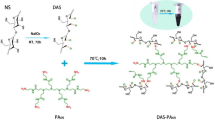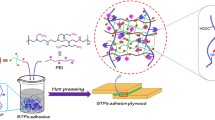Abstract
Adhesives derived from natural biomass, such as starch, cellulose, and plant protein, are attracting attention as alternatives to harmful formaldehyde-based adhesives in the wood adhesive industry. However, biomass-based adhesives have remarkably poor adhesion properties and are easily eroded by bacteria and fungi, which limit their application as adhesives. Therefore, various environmentally friendly adhesives with good adhesive force and antibacterial activity are being explored. In this study, an eco-friendly composite hydrogel with improved adhesive properties was prepared by simply blending starch, a polymeric carbohydrate, with tannic acid, a polyphenol with a large number of catechol and gallol groups. The effect of tannic acid on the recrystallization process of the starch/tannic acid composite hydrogel was investigated through X-ray diffraction, rheological and mechanical studies. As compared with the starch hydrogel, the composite starch/tannic acid hydrogel exhibited improved thermal stability and adhesive strength on various substrates. In particular, its adhesive strength on a wood substrate was significantly enhanced owing to the high adhesive force between tannic acid in the hydrogel and wood substrate. In addition, the composite hydrogel also had antioxidant and antibacterial properties owing to the polyphenolic groups of tannic acid. Thus, the functional starch/tannic acid composite hydrogel has great prospects as an eco-friendly wood adhesive.








Similar content being viewed by others
Data availability
Not applicable.
References
Ai Y, Jl J (2015) Gelatinization and rheological properties of starch. Starch-Stärke 67:213–224
Apostolidis E, Kioupis D, Kakali G et al (2021) Effect of starch concentration and resistant starch filler addition on the physical properties of starch hydrogels. J Food Sci 86:5340–5352
Arias A, González-García S, González-Rodríguez S et al (2020) Cradle-to-gate life cycle Assessment of bio-adhesives for the wood panel industry. A comparison with petrochemical alternatives. Sci Total Environ 738:140357
Bai M, Zhang Y, Bian Y et al (2023) A novel universal strategy for fabricating soybean protein adhesive with excellent adhesion and anti-mildew performances. Chem Eng J 452:139359
Barros F, Awika JM, Rooney LW (2012) Interaction of tannins and other sorghum phenolic compounds with starch and effects on in vitro starch digestibility. J Agric Food Chem 60:11609–11617
Benhamou AA, Boussetta A, Kassab Z et al (2022) Elaboration of carboxylated cellulose nanocrystals filled starch-based adhesives for the manufacturing of eco-friendly particleboards. Constr Build Mater 348:128683
Chang Q, Zheng B, Zhang Y et al (2021) A comprehensive review of the factors influencing the formation of retrograded starch. Int J Biol Macromol 186:163–173
Chen L, Ren F, Zhang Z et al (2015) Effect of pullulan on the short-term and long-term retrogradation of rice starch. Carbohydr Polym 115:415–421
Chen H, Nair SS, Chauhan P et al (2019) Lignin containing cellulose nanofibril application in pMDI wood adhesives for drastically improved gap-filling properties with robust bondline interfaces. Chem Eng J 360:393–401
Chen C, Yang X, Li SJ et al (2021) Red wine-inspired tannic acid–KH561 copolymer: its adhesive properties and its application in wound healing. RSC Adv 11:5182–5191
Delikhoon M, Fazlzadeh M, Sorooshian A et al (2018) Characteristics and health effects of formaldehyde and acetaldehyde in an urban area in Iran. Environ Pollut 242:938–951
Domene-Lopez D, Delgado-Martin JJ, Martin-Gullon I et al (2019) Comparative study on properties of starch films obtained from potato, corn and wheat using 1-ethyl-3-methylimidazolium acetate as plasticizer. Int J Biol Macromol 135:845–854
Du J, Yao F, Zhang M et al (2019) Effect of persimmon tannin on the physicochemical properties of maize starch with different amylose/amylopectin ratios. Int J Biol Macromol 132:1193–1199
Emengo F, Chukwu S, Mozie J (2002) Tack and bonding strength of carbohydrate-based adhesives from different botanical sources. Int J Adhes Adhes 22:93–100
Fan H, Wang J, Zhang Q et al (2017a) Tannic acid-based multifunctional hydrogels with facile adjustable adhesion and cohesion contributed by polyphenol supramolecular chemistry. ACS Omega 2:6668–6676
Fan H, Wang L, Feng X et al (2017b) Supramolecular hydrogel formation based on tannic acid. Macromolecules 50:666–676
Gülçin İ, Huyut Z, Elmastaş M et al (2010) Radical scavenging and antioxidant activity of tannic acid. Arab J Chem 3:43–53
Guo B, Wang Y, Pang M et al (2020) Annealing treatment of amylose and amylopectin extracted from rice starch. Int J Biol Macromol 164:3496–3500
Gwak MA, Hong BM, Park WH (2021) Hyaluronic acid/tannic acid hydrogel sunscreen with excellent anti-UV, antioxidant, and cooling effects. Int J Biol Macromol 191:918–924
Huang Y, Lin Q, Yu Y et al (2020) Functionalization of wood fibers based on immobilization of tannic acid and in situ complexation of Fe (II) ions. Appl Surf Sci 510:145436
Jung J, Raghavendra GM, Kim D et al (2018) One-step synthesis of starch-silver nanoparticle solution and its application to antibacterial paper coating. Int J Biol Macromol 107:2285–2290
Juqing C, Shuguang H, Yan W et al (2016) Improving soy protein adhesive with organic montmorillonite for poplar plywood. Cell Chem Technol 50:847–851
Kim S (2009) Environment-friendly adhesives for surface bonding of wood-based flooring using natural tannin to reduce formaldehyde and TVOC emission. Bioresour Technol 100:744–748
Kim E, Jung JS, Yoon SG et al (2023) Eco-friendly silk fibroin/tannic acid coacervates for humid and underwater wood adhesives. J Colloid Interface Sci 632:151–160
Lee D, Hwang H, Kim JS et al (2020) VATA: a poly (vinyl alcohol)-and tannic acid-based nontoxic underwater adhesive. ACS Appl Mater Interfaces 12:20933–20941
Lee SY, Lee JN, Chathuranga K et al (2021) Tunicate-inspired polyallylamine-based hydrogels for wet adhesion: a comparative study of catechol-and gallol-functionalities. J Colloid Interface Sci 601:143–155
Lei H, Du G, Wu Z et al (2014) Cross-linked soy-based wood adhesives for plywood. Int J Adhes Adhes 50:199–203
Li D, Zhuang B, Wang X et al (2020) Chitosan used as a specific coupling agent to modify starch in preparation of adhesive film. J Clean Prod 277:123210
Luo J, Zhou Y, Gao Q et al (2020) From wastes to functions: a new soybean meal and bark-based adhesive. ACS Sustain Chem Eng 8:10767–10773
Ma H, Qin W, Guo B et al (2022) Effect of plant tannin and glycerol on thermoplastic starch: Mechanical, structural, antimicrobial and biodegradable properties. Carbohydr Polym 295:119869
Pan W, Qi X, Xiang Y et al (2022) Facile formation of injectable quaternized chitosan/tannic acid hydrogels with antibacterial and ROS scavenging capabilities for diabetic wound healing. Int J Biol Macromol 195:190–197
Rezler R, Poliszko S (2010) Temperature dependence of starch gel rheological properties. Food Hydrocolloids 24:570–577
Sahiner N, Sagbas S, Sahiner M et al (2016) Biocompatible and biodegradable poly(Tannic Acid) hydrogel with antimicrobial and antioxidant properties. Int J Biol Macromol 82:150–159
Schirmer M, Jekle M, Becker T (2015) Starch gelatinization and its complexity for analysis. Starch-Stärke 67:30–41
Sun XD, Lan Y, Shi D et al (2015) Determination of molecular driving forces involved in heat-induced corn germ proteins gelation. J Cereal Sci 66:24–30
Sun Y, Gu J, Tan H et al (2018) Physicochemical properties of starch adhesives enhanced by esterification modification with dodecenyl succinic anhydride. Int J Biol Macromol 112:1257–1263
Tratnik N, Kuo PY, Tanguy NR et al (2020) Biobased epoxidized starch wood adhesives: effect of amylopectin and amylose content on adhesion properties. ACS Sustain Chem Eng 8:17997–18005
Wang S, Li C, Copeland L et al (2015) Starch retrogradation: A comprehensive review. Compr Rev Food Sci Food Saf 14:568–585
Wang Y, Hu B, Zhan J et al (2020) Effects of starchy seed crystals on the retrogradation of rice starch. Food Chem 318:126487
Wu J, Liao W, Zhang J et al (2018) Thermal behavior of collagen crosslinked with tannic acid under microwave heating. J Therm Anal Calorim 135:2329–2335
Xu C, Xu Y, Chen M et al (2020) Soy protein adhesive with bio-based epoxidized daidzein for high strength and mildew resistance. Chem Eng J 390:124622
Xu Y, Han Y, Chen M et al (2021) Constructing a triple network structure to prepare strong, tough, and mildew resistant soy protein adhesive. Compos Pt B-Eng 211:108677
Yan J, Zhang L, Li X et al (2022) Effect of temperature on color changes and mechanical properties of poplar/bismuth oxide wood alloy during warm-press forming. J Wood Sci 68:25
Yang M, Rosentrater KA (2021) Cradle-to-gate life cycle assessment of structural bio-adhesives derived from glycerol. Int J Life Cycle Assess 26:799–806
Ye Q, Han Y, Zhang J et al (2019) Bio-based films with improved water resistance derived from soy protein isolate and stearic acid via bioconjugation. J Clean Prod 214:125–131
Younesi H, Pizzi A (2021) Improving properties of phenol- lignin- glyoxal resin as a wood adhesive by an epoxy resin. Eur J Wood Wood Prod 79:199–205
Zhang Y, Ding L, Gu J et al (2015) Preparation and properties of a starch-based wood adhesive with high bonding strength and water resistance. Carbohydr Polym 115:32–37
Zhang J, Xi X, Liang J et al (2019) Tannin-based adhesive cross-linked by furfuryl alcohol-glyoxal and epoxy resins. Int J Adhes Adhes 94:47–52
Zhao S, Xing F, Wang Z et al (2018) High bonding strength and boiling water resistance of soy protein-based adhesives via organosilicon–acrylate microemulsion and epoxy synergistic interfacial enhancement. J Appl Polym Sci 135:46061
Zhou Y, Fang Z, Zeng G et al (2022) Tough protein based adhesive reinforced by molecular spring strengthening strategy. Chem Eng J 436:135023
Zuo AR, Dong HH, Yu YY et al (2018) The antityrosinase and antioxidant activities of flavonoids dominated by the number and location of phenolic hydroxyl groups. Chin Med 13:1–12
Acknowledgments
This work was supported by Basic Science Research Program through the National Research Foundation (NRF) funded by the Korean Government (NRF-2021R1A2B5B02002518).
Funding
The authors have not disclosed any funding.
Author information
Authors and Affiliations
Contributions
I declare that all authors had significant participation in this manuscript. YJJ: prepared composite hydrogels and wrote the original manuscript, KC: conducted antibacterial analyses, JSL: supervised antibacterial test, WHP: supervised whole experiments and revised the manuscript.
Corresponding author
Ethics declarations
Conflict of interest
The authors declare no competing interests.
Ethical approval
Not applicable.
Consent to participate
Not applicable.
Consent for publication
Not applicable.
Additional information
Publisher's Note
Springer Nature remains neutral with regard to jurisdictional claims in published maps and institutional affiliations.
Supplementary Information
Below is the link to the electronic supplementary material.
Rights and permissions
Springer Nature or its licensor (e.g. a society or other partner) holds exclusive rights to this article under a publishing agreement with the author(s) or other rightsholder(s); author self-archiving of the accepted manuscript version of this article is solely governed by the terms of such publishing agreement and applicable law.
About this article
Cite this article
Jeong, Y.J., Chathuranga, K., Lee, J.S. et al. Eco-friendly starch-based hydrogels with improved adhesion, antioxidant, and antimicrobial properties as wood adhesives. Cellulose 30, 7905–7921 (2023). https://doi.org/10.1007/s10570-023-05340-3
Received:
Accepted:
Published:
Issue Date:
DOI: https://doi.org/10.1007/s10570-023-05340-3




